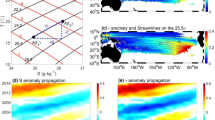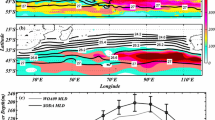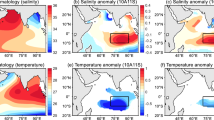Abstract
Spiciness anomalies generated in the salinity maxima region are important for several atmospheric and oceanic factors as they move along the geostrophic pathways towards the equator and resurface. Subduction and injection mechanisms are responsible for the spiciness generation in the South Indian Ocean (SIO) salinity maxima region. Using ECCO data from 1992 to 2017, here we study monthly variations of spiciness associated with both of these mechanisms in the SIO salinity maxima region. Using a Lagrangian approach, we estimated the monthly evolution of the subduction rate. A maximum subduction rate of 35–38 m/mon occurs during September and consequently decreases towards the end of the year. The effective subduction rate in the salinity maxima region shows the dominance of temporal induction (mixed layer tendency) term, with a sharp gradient in total subduction rate along the 30∘S associated with large mixed layer depth variation. Further, a high Turner angle (> 66∘) to the south of 30∘S confirms the generation of spiciness by injection mechanism. We found that the decrease in mixed layer salt (MLS) coincides with the increase in salinity below the mixed layer. To explore the significance of MLS changes in spiciness generation, we further addressed the monthly evolution of spiciness through MLS budget. Our results suggest that the entrainment and meridional advection terms are key to monthly variations in MLS changes and thus the spiciness.










Similar content being viewed by others
Data Availability
The datasets generated and/or analysed in the current study are available from the corresponding author on reasonable request. The following dataset are used for the analysis: ECCOv4 dataset is downloaded from http://apdrc.soest.hawaii.edu/las/v6/dataset?catitem=4941). ARGO data sourced from (http://apdrc.soest.hawaii.edu/las/v6/dataset?catitem=9). Atmospheric fluxes are downloaded through the Copernicus Climate Change Service (C3S) climate Data store (https://cds.climate.copernicus.eu/cdsapp#!dataset/reanalysis-era5-single-levels-monthly-means.
Code Availability
The subduction rate calculation by using lagrangian approach is performed using Ocean parcels (https://github.com/OceanParcels/parcels). Codes for the mixed layer budget calculation can be available from corresponding author.
References
Bindoff NL, Mcdougall TJ (1994) Diagnosing climate change and ocean ventilation using hydrographic data. J Phys Oceanogr 24(6):1137–1152
Bryden HL, McDonagh EL, King BA (2003) Changes in ocean water mass properties: oscillations or trends? Science 300(5628):2086–2088
Bull CYS, van Sebille E (2016) Sources, fate, and pathways of leeuwin current water in the Indian ocean and great Australian bight: a lagrangian study in an eddy-resolving ocean model. J Geophys Res: Oceans 121(3):1626–1639
Cushman-Roisin B (1987) Subduction. Dynamics of the oceanic surface mixed layer, pp 181–196
de Boyer Montégut C, Madec G, Fischer AS, et al. (2004) Mixed layer depth over the global ocean: an examination of profile data and a profile-based climatology. J Geophys Res: Oceans 109(C12003):1–20
Dong S, Gille ST, Sprintall J (2007) An assessment of the southern ocean mixed layer heat budget. J Clim 20(17):4425–4442
Forget G, Campin JM, Heimbach P, et al. (2015) Ecco version 4: an integrated framework for non-linear inverse modeling and global ocean state estimation. Geosci Model Dev 8(10):3071–3104
Fukumori I, Wang O, Fenty I et al (2017) Ecco version 4 release 3. Tech. rep.
Furue R, Guerreiro K, Phillips HE, et al. (2017) On the leeuwin current system and its linkage to zonal flows in the south Indian ocean as inferred from a gridded hydrography. J Phys Oceanogr 47(3):583–602
Gu D, Philander SG (1997) Interdecadal climate fluctuations that depend on exchanges between the tropics and extratropics. Science 275(5301):805–807
Hersbach H, Bell B, Berrisford P, et al. (2020) The era5 global reanalysis. Q J R Meteorol Soc 146(730):1999–2049
Iselin CO (1939) The influence of vertical and lateral turbulence on the characteristics of the waters at mid-depths. Eos, Trans Am Geophys Union 20(3):414–417
Johnson GC (2006) Generation and initial evolution of a mode water 𝜃–s anomaly. J Phys Oceanogr 36(4):739–751
Johnson BK, Bryan FO, Grodsky SA, et al. (2016) Climatological annual cycle of the salinity budgets of the subtropical maxima. J Phys Oceanogr 46(10):2981–2994
Karstensen J, Quadfasel D (2002) Formation of southern hemisphere thermocline waters: water mass conversion and subduction. J Phys Oceanogr 32(11):3020–3038
Kolodziejczyk N, Gaillard F (2012) Observation of spiciness interannual variability in the pacific pycnocline. J Geophys Res: Oceans 117(C12)
Kolodziejczyk N, Gaillard F (2013) Variability of the heat and salt budget in the subtropical southeastern pacific mixed layer between 2004 and 2010: spice injection mechanism. J Phys Oceanogr 43(9):1880–1898
Kouketsu S, Osafune S, Kumamoto Y, et al. (2017) Eastward salinity anomaly propagation in the intermediate layer of the North Pacific. J Geophys Res: Oceans 122(2):1590–1607
Lange M, Ev Sebille (2017) Parcels v0. 9: prototyping a lagrangian ocean analysis framework for the petascale age. Geoscientific Model Dev 10(11):4175–4186
Li Y, Wang F (2015) Thermocline spiciness variations in the tropical indian ocean observed during 2003–2014. Deep Sea Res Part I: Oceanogr Res Pap 97:52–66
Liu H, Li S, Wei Z (2021) Interannual variability in the subduction of the south atlantic subtropical underwater. Clim Dyn 57:1061– 1077
Luo Y, Rothstein LM, Zhang RH, et al. (2005) On the connection between south pacific subtropical spiciness anomalies and decadal equatorial variability in an ocean general circulation model. J Geophys Res: Oceans 110(C10002):1–14
Luyten J, Pedlosky J, Stommel H (1983) The ventilated thermocline. J Phys Oceanogr 13 (2):292–309
McCreary JP, Lu P (1994) Interaction between the subtropical and equatorial ocean circulations: the subtropical cell. J Phys Oceanogr 24(2):466–497
McDougall TJ, Krzysik OA (2015) Spiciness. J Mar Res 73(5):141–152
Moore JK, Abbott MR (2002) Surface chlorophyll concentrations in relation to the antarctic polar front: seasonal and spatial patterns from satellite observations. J Mar Syst 37(1–3):69–86
Munk W (1981) Internal waves and small-scale process. Evol Phys Oceanogr 264:291
Nagura M, Kouketsu S (2018) Spiciness anomalies in the upper south Indian ocean. J Phys Oceanogr 48(9):2081–2101
Nonaka M, Sasaki H (2007) Formation mechanism for isopycnal temperature–salinity anomalies propagating from the eastern south pacific to the equatorial region. J Clim 20(7):1305– 1315
Paulson CA, Simpson JJ (1977) Irradiance measurements in the upper ocean. J Phys Oceanogr 7(6):952–956
Ponte R, Vinogradova N (2016) An assessment of basic processes controlling mean surface salinity over the global ocean. Geophys Res Lett 43(13):7052–7058
Qiu B, Huang RX (1995) Ventilation of the north Atlantic and north Pacific: subduction versus obduction. J Phys Oceanogr 25(10):2374–2390
Sabine CL, Feely RA, Gruber N, et al. (2004) The oceanic sink for anthropogenic co2. Science 305(5682):367–371
Sallée J B, Wienders N, Speer K, et al. (2006) Formation of subantarctic mode water in the southeastern Indian ocean. Ocean Dyn 56(5):525–542
Sarmiento JL, Gruber N, Brzezinski M, et al. (2004) High-latitude controls of thermocline nutrients and low latitude biological productivity. Nature 427(6969):56–60
Schneider N (2000) A decadal spiciness mode in the tropics. Geophys Res Lett 27(2):257–260
Schott FA, Xie SP, McCreary Jr JP (2009) Indian ocean circulation and climate variability. Reviews of Geophysics 47(1)
Stommel H (1962) On the cause of the temperature-salinity curve in the ocean. Proc Natl Acad Sci U S A 48(5):764
Stommel H (1979) Determination of water mass properties of water pumped down from the ekman layer to the geostrophic flow below. Proc Natl Acad Sci 76(7):3051–3055
Tyler J, Jerlov NG (1968) Optical oceanography. American Elsevier Publ. Co., Inc., New York. 194 pp. 13.50
Veronis G (1972) Properties of seawater defined by temperature, salinity, and pressure. J Mar Res 30(2):227
Wang Y, Luo Y (2020) Variability of spice injection in the upper ocean of the southeastern pacific during 1992–2016. Clim Dyn 54(5):3185–3200
Wang Y, Li Y, Wei C (2020) Subtropical sea surface salinity maxima in the south Indian ocean. J Oceanol Limnol 38(1):16–29
Wijffels S, Sprintall J, Fieux M, et al. (2002) The jade and woce i10/ir6 throughflow sections in the southeast Indian ocean. Part 1: water mass distribution and variability. Deep Sea Res Part II: Top Stud Oceanogr 49(7–8):1341–1362
Wong AP, Bindoff NL, Church JA (1999) Large-scale freshening of intermediate waters in the pacific and Indian oceans. Nature 400(6743):440–443
Woods J (1985) The physics of thermocline ventilation. In: Elsevier oceanography series, vol 40. Elsevier, pp 543–590
Yang L, Murtugudde R, Zhou L, et al. (2020) A potential link between the southern ocean warming and the south Indian ocean heat balance. J Geophys Res: Oceans 125(12):e2020JC016, 132
Yeager SG, Large WG (2007) Observational evidence of winter spice injection. J Phys Oceanogr 37(12):2895–2919
Acknowledgements
This work has been carried out at India Institute of Technology Kharagpur, India. Authors would like to thank Institute for providing all needed support to carry out this research. We would like to thank the anonymous reviewers for their comments and suggestions which helped to improve the manuscript significantly. Madhu Kaundal thanks Ministry of Human Resource Development, Government of India for the research fellowship. All the analysis and plotting is done in python using packages numpy, xarray, and matplotlib.
Funding
DS was funded by the Ministry of Education Academic Research Fund MOE2019-T3-1-004, the National Research Foundation Singapore, and the Singapore Ministry of Education, under the Research Centres of Excellence initiative. This work comprises Earth Observatory of Singapore contribution no. 434. MKD was funded by the climate change project of Department of Science and Technology, Govt. of India.
Author information
Authors and Affiliations
Corresponding author
Ethics declarations
Conflict of interest
All authors declare that they have no conflicts of interest.
Additional information
Responsible Editor: Yasumasa Miyazawa
Publisher’s Note
Springer Nature remains neutral with regard to jurisdictional claims in published maps and institutional affiliations.
Electronic supplementary material
Below is the link to the electronic supplementary material.
Rights and permissions
About this article
Cite this article
Kaundal, M., Raju, N.J., Samanta, D. et al. Seasonal and spatial variations in spice generation in the South Indian Ocean salinity maxima. Ocean Dynamics 72, 313–323 (2022). https://doi.org/10.1007/s10236-022-01502-2
Received:
Accepted:
Published:
Issue Date:
DOI: https://doi.org/10.1007/s10236-022-01502-2




